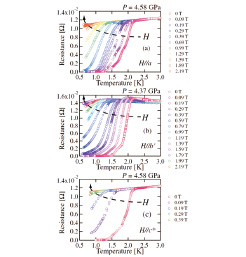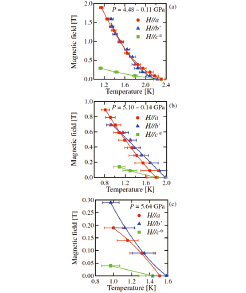Anisotropy of Upper Critical Field in a One-Dimensional Organic System, (TMTTF)2PF6 under High Pressure
M. Kano and M. Itoi
The Bechgaard salt (TMTSF)2PF6 (TMTSF = tetramethyltetraselenafulvalene) was the first organic superconductor discovered in 1980 with a superconducting temperature of Tc = 0.9 K (critical pressure, Pc =1.2 GPa) [1]. Since this discovery, materials based on TMTSF and its derivatives, such as TMTTF (tetramethyltetrathiofulvalene), the so-called (TMTCF)2X (X = monovalent anion) series, have been investigated extensively to search for other superconducting behaviors. They also attracted attention owing to their rich properties such as spin-Peierls (SP), charge-ordering (CO), spin density wave (SDW), and possible unconventional superconductivity (SC) that appear by changing the counter anion or by applying external pressure [2]. Many compounds with TMTSF molecules exhibit an SC state at low pressures of approximately 1 GPa, whereas most compounds with TMTTF exhibit an SC transition at ultra high pressures, for example, Pc= 5 GPa in (TMTTF)2PF6 [3,4,5]. Taking advantage of the low pressure induced and ambient pressure superconductivity, the characteristic for SC phase has been well studied with TMTSF salts, but rarely with TMTTF salts owing to the technical difficulty in applying hydrostatic pressure to the fragile organic compounds at low temperatures in magnetic fields. Recently, we have succeeded in resistivity measurement by using a turnbuckle-type Diamond anvil cell (DAC) on (TMTTF)2PF6 under multi-extreme conditions which was previously difficult to achieve [6]. We report on the characteristic superconductivity on (TMTTF)2PF6.

Fig. 1. The temperature-dependent resistivity of (TMTTF)2PF6 was measured up to 7 GPa using a turnbuckle-type diamond anvil cell (DAC) and at magnetic fields of up to 5 T. The applied magnetic fields were (a) parallel to the a-axis at P =4.58 GPa, (b) b’-axis at P = 4.37 GPa and (c) c*-axis at P = 4.58 GPa.

Fig. 2. Hc2 curves with applied fields H || a, H || b’ and H || c* for P = (a) 4.48, (b) 5.10 and (c) 5.64 GPa obtained by using the onset criterion.
The resistivity of (TMTTF)2PF6 one-dimensional exhibits strong anisotropy at ambient pressure. In the stacking direction of TMTTF molecules (a-axis), the metal–insulator (M–I) transition was suppressed with increasing external pressure, and the superconductivity was observed in the range of P = 4.18 to 6.03 GPa. The highest SC transition temperature is Tc =2.25 K at 4.58 GPa, and no SC transition was observed above P = 6.96 GPa. The presence of zero resistance was confirmed at approximately 1.5 K in the pressure range of 4.18 ≤ P ≤ 4.58 GPa.
Data of resistivity vs temperature at P = 4.37-4.58 GPa with the field along three different axes are shown in Fig. 1, and the temperature dependence of Hc2 along the three axes on (TMTTF)2PF6 is described in Fig. 2.
The Hc2 has a positive curvature without saturation, which may be attributed to an FFLO state, for a magnetic field along the a (intra-chain direction) – and b’(inter-chain direction)- axes at T ≥ 0.5 K for P = 4.48 GPa. We also have shown that the upturn feature is suppressed with increasing pressure and the orbital pair breaking mechanism becomes dominant. In further studies of the pair breaking mechanism, measurement should be conducted at lower temperatures and with more refined pressure control. Our data above T = 0.5 K shows that Hc2 slightly exceeds the Pauli paramagnetic limit at P =4.48 GPa for H || a . Hc2 curves for H || a and H || b’ lie on top of each other indicating that it has a two-dimensional-like feature, being isotropic within the ab’ -plane. GL coherence lengths were obtained, which are highly anisotropic, for example, ξa : ξb’ : ξc= 5 : 5 : 1 at P = 5.64 GPa. The interlayer coherence length ξc is much larger than the thickness of the conducting sheet for all pressures, which is c/2 ~ 6.5 Å , where c is a lattice parameter of (TMTTF)2PF6. These results revealed that (TMTTF)2PF6 is an anisotropic three-dimensional superconductor.
References
- [1] D. Jérome, A. Mazaud, M. Ribault, and K. Bechgaard, J. Phys. Lett. 41, 95 (1980).
- [2] D. Jérome, Science 252, 1509 (1991).
- [3] T. Adachi, E. Ojima, K. Kato, H. Kobayashi, T. Miyazaki, M. Tokumoto, and A. Kobayashi, J. Am. Chem. Soc. 122, 3238 (2000).
- [4] D. Jaccard, H. Wilhelm, D. JeÅLrome, J. Moser, C. Carcel, and J. M. Fabre, J. Phys.: Condens. Matter 13, L89 (2001).
- [5] C. Araki, M. Itoi, M. Hedo, Y. Uwatoko, and H. Mori, J. Phys. Soc. Jpn. 76, Suppl. A 198 (2007).
- [6] M. Kano, H. Mori, K. Matsubayashi, M. Itoi, M. Hedo, T. P. Murphy, S. W. Tozer, Y. Uwatoko, and T. Nakamura, J. phys. Soc. Jpn. 81, 024716 (2012).
